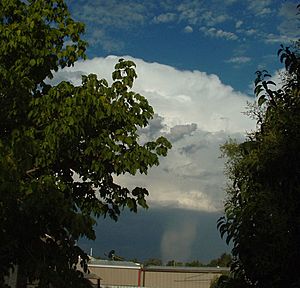Atmospheric convection facts for kids
Atmospheric convection is a super important process that happens in Earth's atmosphere. It's all about how air moves up and down. This movement helps spread heat and moisture around the planet. It's also how we get many types of weather, like clouds and thunderstorms!
Contents
What is Atmospheric Convection?
Atmospheric convection happens for two main reasons.
- Sometimes, the air itself becomes unstable. Think of it like a wobbly stack of blocks ready to fall over. This is called spontaneous convection. It can start high up in the sky or closer to the ground.
- More often, it happens because different parts of Earth's surface heat up unevenly. This is called contact convection. It usually starts right near the ground.
How Does Contact Convection Work?
Contact convection is the most common type. Imagine the sun shining down on the ground. The ground gets warmer and warmer. This heat then warms the air right above it.
Why Warm Air Rises
Warm air is lighter than cold air. This is because warm air has a lower density. Think of a hot air balloon; it rises because the air inside is heated, making it lighter than the air outside. In the same way, the warm air near the ground starts to rise. This rising motion is called a vertical draft.
As this warm air rises, it slows down a bit because of friction with the surrounding air. It keeps rising until its temperature becomes the same as the air around it. But even then, it might keep going up a little further because of its own push, which is called inertia.
Convection in Action: Gliding
These rising currents of warm air, called thermals, are very useful! For example, people who fly gliders use them. Gliders don't have engines, so they rely on these thermals to gain height. The warm air currents have enough energy to lift the gliders higher into the sky, allowing them to fly for longer periods.
Related pages
Images for kids
See also
 In Spanish: Convección atmosférica para niños
In Spanish: Convección atmosférica para niños







